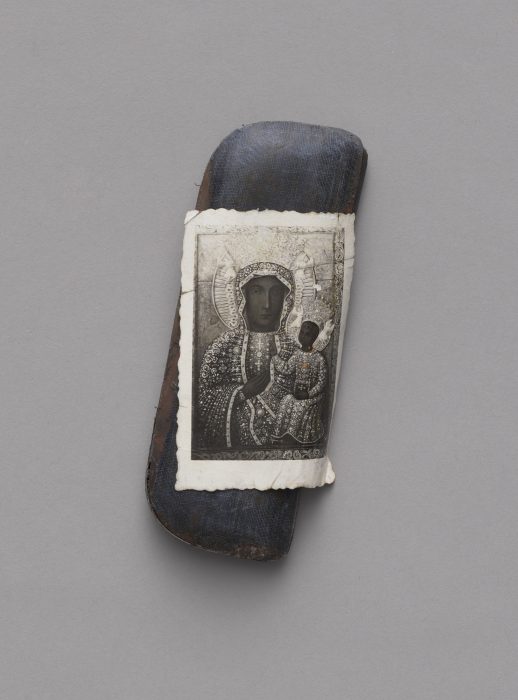
Glasses case with an image of our Lady of Częstochowa
The metal case with outer paper veneer and interior lined with broadcloth was produced in the 1930s by Gustaw Gerlach’s Factory, whose offer comprised aircraft instruments, typewriters and binoculars, among other products. “4 Ossolińskich Street” printed inside on a silk pad for cleaning glasses was the address of the company store.
The case belonged to 23-year-old Andrzej Wojno (1921–1944), scout of the 16th Zawisza Czarny Warsaw Scouting Team, employee of Kazimierz Szpotański’s Electrical Apparatus Factory in the Praga district of Warsaw under the German occupation during World War II, and soldier of the 1st Company of the 3rd “Golski” Armoured Battalion of the Home Army. Wojno perished on 19 August 1944 in the Warsaw Uprising, organised by conspiratorial armed forces (Home Army) against the German occupier, during the defence of the edifice of the Warsaw University of Technology. He was buried on 21 August at 17 Śniadeckich Street, the location of a makeshift cemetery.
The insurgents and civilians who had lost their lives were temporarily buried in the streets, backyards and on the squares within the city centre. Corked bottles with information about the victims were left together with their bodies and personal items, unless they were given to their closest relatives and friends. After the war – since the spring of 1945 until the early 1950s – the Polish Red Cross carried out exhumations which were motivated by sanitary reasons, respect for the buried individuals, and the need to record losses incurred by the population of Warsaw. Relatives and friends of the victims often participated in the exhumations. The exhumed bodies were carried or transported by the Municipal Funeral Company to Warsaw cemeteries, such as the Powązki Cemetery, the Powązki Military Cemetery and the Warsaw Insurgents Cemetery. An empty glasses case was found with Andrzej Wojno, with the image of Our Lady of Częstochowa pasted to it. The icon has been the object of a special cult among Poles since the end of the 14th century. According to the family, both objects were glued to each other by means of blood. That relic, as well as a wallet with a metal monogram, a wad of banknotes from the period of the German occupation and a medallion with the image of Virgin Mary, alongside photographs and documents, were donated to the Museum in 2006 by Andrzej Wojno’s closest family.
Glasses case with an image of our Lady of Częstochowa
GUSTAW GERLACH FACTORY
WARSAW; 1930S
METAL, PAPER VENEER, BROADCLOTH, SILK, FACTORY PRODUCT,
PAPER, PRINT
MHW 26638/1–2
GLASSES CASE: 14,8 × 5,5 × 1,5 CM
IMAGE: 9,2 × 6 CM
Image licensed under: ![]()
